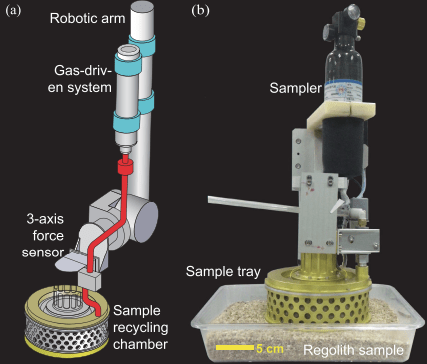Asteroid sampling missions are getting increasingly complex. Recent announcements about the existence of amino acids in the sample OSIRIS-REx returned from Bennu in 2023 will likely result in more interest in studying the small bodies strewn throughout our solar system. Engineering challenges abound when doing so, though, including one of the most important – how to collect a sample from the asteroid. A new paper from researchers at the China Academy of Space Technology looks at a gas-drive sample system they believe could hold the key to China’s future asteroid sample return mission.
There are three main categories of successful asteroid sampling missions – shooting, drilling, and puffing. The original Hayabusa mission in 2010 was an example of the first method – it fired a bullet into the asteroid’s surface after performing a “soft landing.” It used the force of the bullet’s impact to shoot fragments into a collection system. This has the advantage of not requiring the spacecraft to be anchored to the asteroid but isn’t very effective at breaking through hard surfaces.
The puffing method, which OSIRIS-REx used during its visit to Bennu, has the same advantages and disadvantages. Instead of a bullet, it puffed nitrogen at the surface as part of its Touch-and-Go Sample Acquisition Mechanism (TAGSAM).
Rosetta took a shirt approach, though it did not successfully collect any sample from an asteroid due to problems with its lander, Philae. Philae had a drill called the SD2, intended to bore into the surface of comet 67P/Churyumov-Gerasimenko. It also included a sampling tube that extended through the drill to collect the material. This might have worked, but it required significant power and force on the lander.
In the new paper, the researchers took a hybrid approach to developing their regolith sampling system. It utilizes a pneumatic drill that punches a hole in the regolith rather than spinning to drill one directly. After the hole is punched, the system retracts the drill bit and pushes gas down into the hole to force some of the particles up in a sample collector.
According to the team’s simulations and experiments, this method works well in both microgravity and regular gravity environments. It also operated with various granular materials, ranging from hard marble to fine sand. More pressure (i.e., more gas) was needed to collect larger particles, but any future mission can estimate the necessary gas reserves well in advance.
Credit – Zhao et al.
There is a good chance that a future mission will use a sampling system like this. Much of the paper discusses how China is rapidly becoming a space scientific power and how the country’s interest in asteroid resources is growing. The research was funded by several governmental organizations in China, and the country has already shown an interest in asteroid sample return, with the Tianwen-2 mission planned for launch later this year. This hybrid sampling approach might someday be adopted, though it remains to be seen if it will stand the test of a rendezvous with an actual asteroid.
Learn More:
Zhao et al – Gas-Driven Regolith-Sampling Strategy for Exploring Micro-Gravity Asteroids
UT – The Building Blocks for Life Found in Asteroid Bennu Samples
UT – Asteroid Samples Returned to Earth Were Immediately Colonized by Bacteria
UT – OSIRIS-REx’s Final Haul: 121.6 Grams from Asteroid Bennu
Lead Image:
Image of the regolith sampling system under test.
Credit – Zhao et al.

